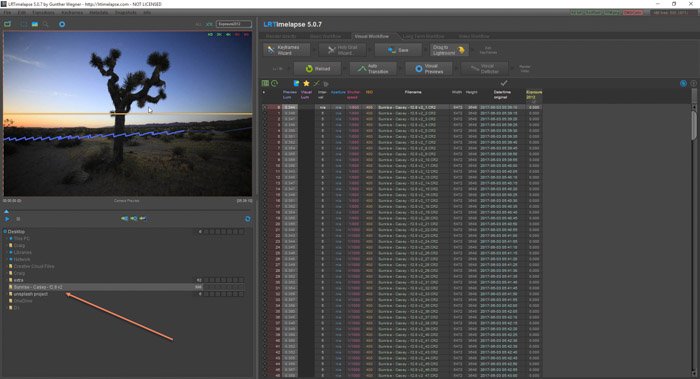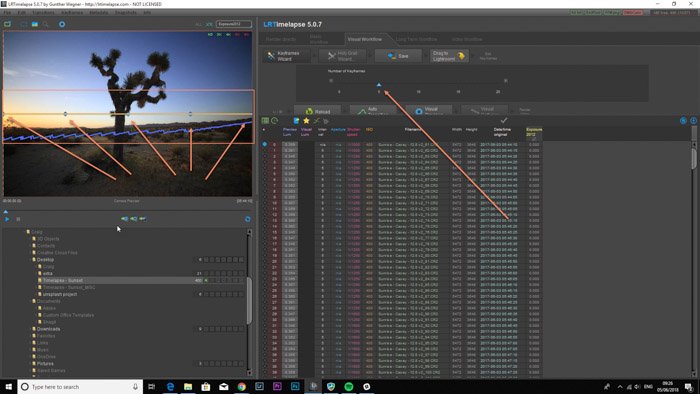
- LRTIMELAPSE LIGHTROOM CANNOT IMPORT MOVIE
- LRTIMELAPSE LIGHTROOM CANNOT IMPORT ISO
- LRTIMELAPSE LIGHTROOM CANNOT IMPORT SERIES
NOTE: This article appeared originally in Issue #9 of Dark Sky Travels e-magazine. But taking time-lapses does require some specialized gear, techniques, planning, and software. Shooting hundreds of frames for a time-lapse will be a disappointing waste of your time if all the images are dark and blurry.įor that reason many of my tips apply equally well to shooting still images.
LRTIMELAPSE LIGHTROOM CANNOT IMPORT SERIES
Here are my tips for taking time-lapses, in a series of “Do’s” and “Don’ts” that I’ve found effective for ensuring great results.īut before you attempt a time-lapse, be sure you can first capture well-exposed and sharply focused still shots.
LRTIMELAPSE LIGHTROOM CANNOT IMPORT MOVIE
But if you have the patience, the result can be an impressive time-lapse movie of the night sky sweeping over a scenic landscape.

There’s little extra work required, just your time. If you can take one well-exposed image of a nightscape, you can take 300.

I present my top 10 tips for capturing time-lapses of the moving sky. The final version was assembled with TLDF’s All Frames mode (shown above) where every frame gets stacked for an accumulated total, to show the busy sky traffic! I then assembled exported JPGs with TimeLapseDeFlicker, using a 3-frame Lighten blend mode to lengthen the trails. The frames were processed in Adobe Camera Raw and LRTimelapse TimeLapse DeFlicker at work assembling the video, showing its All Frames + Lighten blend mode for the Accumulating version of clip #2. LRTimelapse at work processing the second sequence, deflickering some of the oddly exposed frames. A slight glitch appears near the end where I swapped camera batteries, and the camera turned ever so slightly causing the stars to enlarge a bit for a moment. So the stars remained better fixed over the 5.5 hours of shooting. In the second clip from January 20, taken with a quarter Moon lighting the sky, the mount was autoguided, using an MGEN3 auto-guider. Clouds pass through the field during the shoot. The field also drifts north due to slight misalignment on the pole. So the stars wobble back and forth slightly due to periodic error in the mount. In the first sequence from January 18 the equatorial mount, an Astro-Physics Mach1, is left to track on its own and is unguided.
LRTIMELAPSE LIGHTROOM CANNOT IMPORT ISO
The camera was a Canon 6D MkII at ISO 3200 on January 18 and ISO 1600 on January 20 in the brighter moonlight that night. The William Optics RedCat 51mm f/5 astrographic refactor.Įach exposure is 30 seconds long, taken at a one second interval. Both are made from hundreds of frames taken through a William Optics RedCat astrograph at f/5 with a 250mm focal length. The video at top contains time-lapses shot on two nights: January 18 and 20, 2021. TECH DETAILS FOR “TRACKS OF THE GEOSATS” VIDEO: For a video of that phenomenon see my video shot in October 2020, below. During flare season around the two equinoxes geosats can become bright enough to be seen with the unaided eye. The satellites are visible because they are high enough to reflect sunlight even in the middle of the night, as the sequences each end about 11:30 to midnight local time.īut in this video the satellites are not flaring - this is their normal brightness.

You’ll also see some flashing or pulsing satellites - they are likely tumbling objects, perhaps spent rocket boosters. You’ll notice some satellites travelling diagonally - they are not geosats. From a site in the southern hemisphere the geosat belt would appear north of the celestial equator. So parallax makes the geosat belt appears south of the celestial equator in my sky. That’s because I live north of the equator of the Earth, at a latitude of 51° north. In this video, however, they appear about 5° to 7° south of the celestial equator (which runs through the famous Belt of Orion off frame at top). The green box is the field of view of the telescope (shown below) that I used to take the time-lapses. This chart from SkySafari shows the belt of geosats through southern Orion with the satellites identified. The region of sky in Orion below the Orion Nebula (the object at top) lies south of the line that bisects the sky into northern and southern halves called the “celestial equator.” Most geostationary satellites also orbit in Earth’s equatorial plane and so appear along a belt near the celestial equator in the sky. But in reality, it is the stars that are in motion behind the satellites. What would normally be satellites fixed in one spot in the sky (after all, they are called “geostationary” for a reason) instead trail into short streaks traveling from west to east (right to left) in the frame.

The camera is on a mount that is tracking the sky as it turns from east to west, so the stars are staying still.


 0 kommentar(er)
0 kommentar(er)
